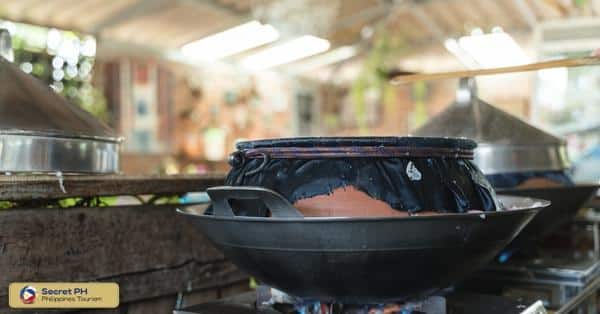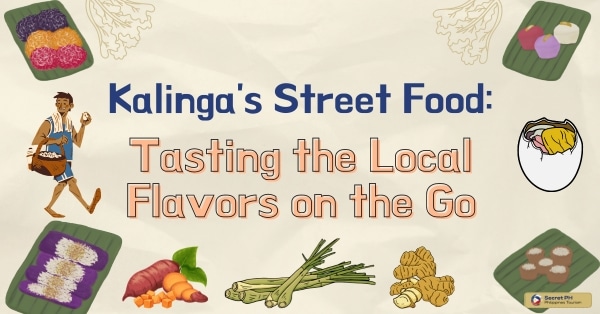Unearth the culinary treasures of the Kalinga region, where history and tradition converge on your plate. Explore unique ingredients sourced from local harvests and wild foraging, and savor signature dishes like Pinikpikan, prepared using time-honored methods. Trace the evolution of Kalinga cuisine amidst external influences and find out where to embark on this flavorful journey through the mountains of Kalinga.
In this blog post, we will explore the culinary heritage of the Kalinga region, its ingredients and cooking methods as well as where you can experience authentic Kalinga Cuisine! So join us on a journey through time and space as we uncover the hidden secrets of Kalinga Cuisine.

The Culinary Heritage of the Kalinga Region
The culinary heritage of the Kalinga region is a testament to the deep-rooted traditions and cultural richness of its indigenous communities. Nestled amidst the rugged mountains of the Philippines, Kalinga’s food culture is a reflection of its people’s resilience and connection to the land.
Rituals and practices that center around food, such as the historic “punnuk” victory feasts and ceremonial preparations, highlight the sacred role of cuisine in Kalinga life. This culinary legacy not only showcases the region’s diverse flavors and ingredients but also serves as a symbol of Kalinga’s enduring identity and cultural heritage, bridging the past and the present in a flavorful journey.

Unique Ingredients of Kalinga Cuisine
The heart of any culinary tradition lies in its ingredients, and Kalinga cuisine is no exception. Nestled in the mountainous terrain of the Philippines, the Kalinga region boasts a distinctive array of ingredients that not only define its cuisine but also reveal the deep connection between the people and their environment.
From locally grown produce to uncommon finds from wild foraging, Kalinga’s ingredients are a treasure trove waiting to be explored. Let’s delve into the unique elements that make Kalinga cuisine a gastronomic adventure like no other.

The Bountiful Harvest: Locally Grown Produce
Kalinga’s fertile soil and favorable climate yield a diverse range of crops, including heirloom rice varieties, root vegetables, and leafy greens. The terraced rice fields, known as “payos,” are a stunning testament to the agricultural expertise of the Kalinga people. The region’s rice, often referred to as “tinawon,” is celebrated for its unique flavors and textures, making it a cornerstone of many Kalinga dishes.
Uncommon Ingredients: Wild Foraging and Hunting
Kalinga’s rugged landscapes are teeming with edible treasures sourced from the wild. From edible ferns known as “pako” to the forest-grown “egon,” a type of mushroom, Kalinga residents have mastered the art of foraging. Wild game, such as wild boar and deer, also find their way into Kalinga cuisine, adding a distinct taste to the culinary repertoire.
Indigenous Herbs and Spices
To elevate their dishes, Kalinga chefs rely on a variety of indigenous herbs and spices. Ingredients like “ngakiw,” a wild ginger, and “alibangbang,” a souring agent, are used to infuse unique flavors into the cuisine. These locally sourced herbs and spices not only enhance taste but also reflect the region’s commitment to preserving its culinary heritage.

Traditional Cooking Methods
In the heart of the Kalinga region’s culinary heritage lies a fascinating array of traditional cooking methods. These time-honored techniques have been passed down through generations, shaping the unique flavors and textures that define Kalinga cuisine. As we explore these methods, we gain insight into the profound connection between the people of Kalinga and their food, a relationship rooted in tradition, innovation, and a deep reverence for nature.

Hearth Cooking: A Time-Honored Technique
At the core of Kalinga’s culinary traditions is the use of open hearths, known as “dap-ay.” These communal cooking spaces are not just functional but also symbolic, serving as gathering points for the community. Here, dishes like “pinikpikan” (a flavorful chicken dish) and “inanchila” (a hearty pork stew) are prepared over an open flame, infusing them with a smoky, earthy flavor that’s quintessentially Kalinga.
Bamboo and Leaf Wrapping
One of the distinctive methods in Kalinga cuisine involves the use of bamboo and leaves for cooking. Ingredients are enclosed within bamboo tubes or wrapped in large, sturdy leaves, then placed over an open flame or buried in hot coals. This technique, known as “ginataang bulaklak,” imparts a unique aroma and tenderness to the food, creating a delightful sensory experience.
Fermentation and Preservation Techniques
Kalinga cuisine also showcases a mastery of fermentation and preservation. Ingredients like fish and vegetables are fermented to create condiments like “basi,” a local sugarcane wine, and “etag,” a sun-dried and smoked meat. These preservation methods not only extend the shelf life of ingredients but also infuse them with complex flavors that add depth to many Kalinga dishes.
The traditional cooking methods of Kalinga are more than just culinary techniques; they are a testament to the region’s cultural identity and the ingenuity of its people. These methods not only result in delicious dishes but also serve as a bridge to the past, connecting the Kalinga of today with their ancestors’ time-honored culinary practices.

Signature Kalinga Dishes
In the lush landscapes of the Kalinga region, culinary traditions have thrived for generations, giving rise to a unique repertoire of signature dishes. These dishes are not only delicious but also tell the story of the Kalinga people’s connection to their land and their rich cultural heritage. From hearty stews to mouthwatering delicacies, here are some of the signature Kalinga dishes that exemplify the region’s vibrant culinary tradition.
Pinikpikan: A culinary icon of Kalinga, Pinikpikan is a chicken dish prepared with a distinctive twist. The chicken is ritualistically beaten with a stick before cooking, resulting in tender and flavorful meat. It is often seasoned with local herbs and spices, providing a burst of unique Kalinga flavors.
Inanchila: This hearty pork stew is a comfort food favorite in Kalinga. Made with succulent pieces of pork cooked with vegetables and spices, Inanchila reflects the region’s agricultural abundance and skillful culinary techniques.
Ampalaya Salad: Ampalaya, or bitter gourd, takes center stage in this refreshing salad. It is often combined with tomatoes, onions, and a tangy vinaigrette dressing. The bitterness of the ampalaya is balanced by the bright and zesty flavors of the other ingredients, creating a harmonious dish.
Uyauy: Kalinga cuisine wouldn’t be complete without uyauy, a category of rice-based delicacies. From “kinuday” (sticky rice cakes) to “binalay” (rice tamales), these treats showcase the versatility of rice in Kalinga cuisine, whether sweet or savory.
Tapey: To round off a meal, indulge in tapey, a traditional rice wine. Made from fermented rice, tapey boasts a mild sweetness and a subtle alcoholic kick, making it a delightful beverage choice in Kalinga.

Culinary Influences and Evolution
Kalinga cuisine, though deeply rooted in its indigenous heritage, has not remained impervious to the winds of change and external influences. Over the years, various cultural exchanges, trade routes, and migrations have left their mark on Kalinga’s culinary landscape.
These influences have led to the evolution and diversification of traditional recipes, introducing new ingredients and cooking methods. Modern interpretations of Kalinga dishes often incorporate elements from neighboring regions and global cuisines, creating a fusion of flavors that reflects the dynamic nature of contemporary Kalinga cuisine. Despite these external influences, Kalinga’s culinary identity remains robust, anchored in its rich traditions and a willingness to adapt while preserving its core heritage.

Where to Experience Kalinga Cuisine
Embarking on a culinary journey through the picturesque Kalinga region is an adventure for the senses. The flavors, ingredients, and traditions that define Kalinga cuisine are best experienced in their place of origin. If you’re eager to savor the authentic tastes of this mountainous paradise, here’s a list of places and experiences where you can immerse yourself in Kalinga’s rich culinary heritage.
1. Adam’s Delight
Address: Tabuk, Kalinga
Opening Hours: 8 AM–3 PM
Phone: 0917 560 6687
For directions, click here.
2. Girlfriends Avenue
Address: Omengan bldg, P Burgos, Tabuk, 3800 Kalinga
Opening Hours: 8 AM–12 PM
For directions, click here.
3. Gangsa Cafe
Address: CCFV+62H, Tabuk, Kalinga
For directions, click here.
4. Ethnic Boutique
Address: CC4G+X26, Bulanao Bridge II, Tabuk, Kalinga
Opening Hours: 8 AM–7:30 PM
For directions, click here.
5. Boodle Season Seafood Restaurant
Address: 9CWR+MC8, Bulanao – Paracelis Rd, Tabuk, Kalinga
Opening Hours: 8 AM–8 PM
For directions, click here.

In conclusion
A culinary experience that should not be overlooked. With an abundance of ingredients sourced from local harvests and wild foraging, as well as traditional cooking methods passed down through generations, Kalinga cuisine showcases the region’s connection to its land and cultural heritage. From signature dishes like Pinikpikan to modern interpretations of traditional recipes, Kalinga cuisine is an adventure for the senses that shouldn’t be missed.








